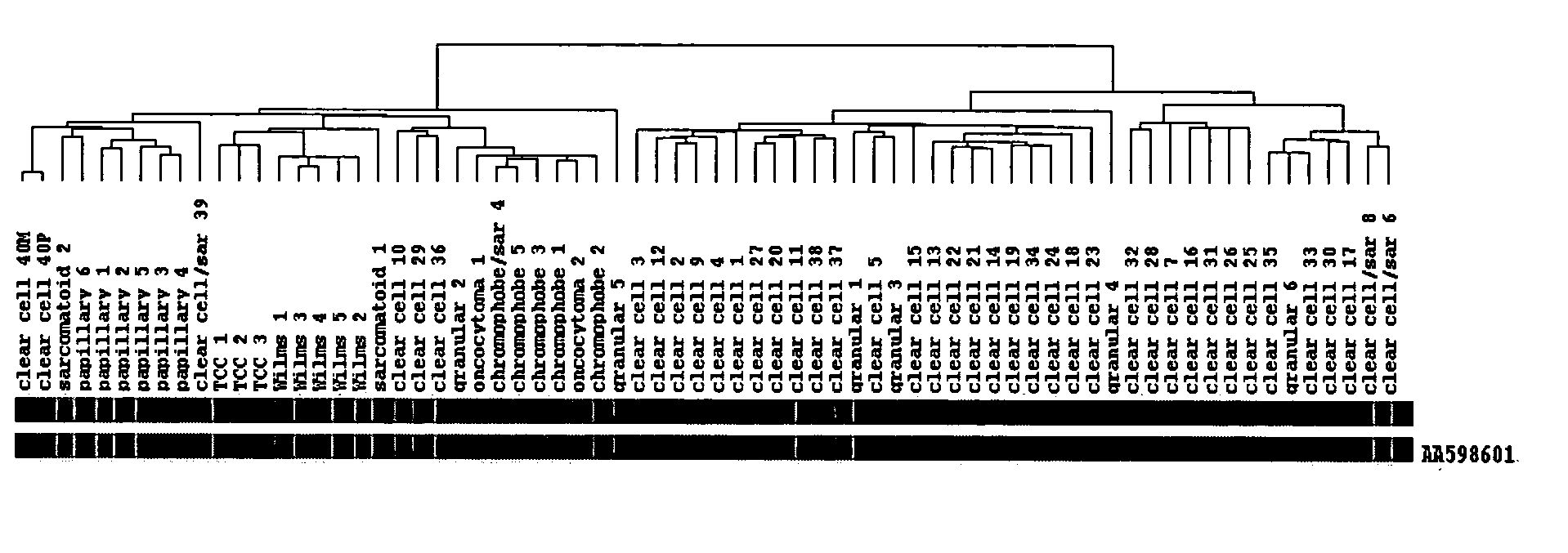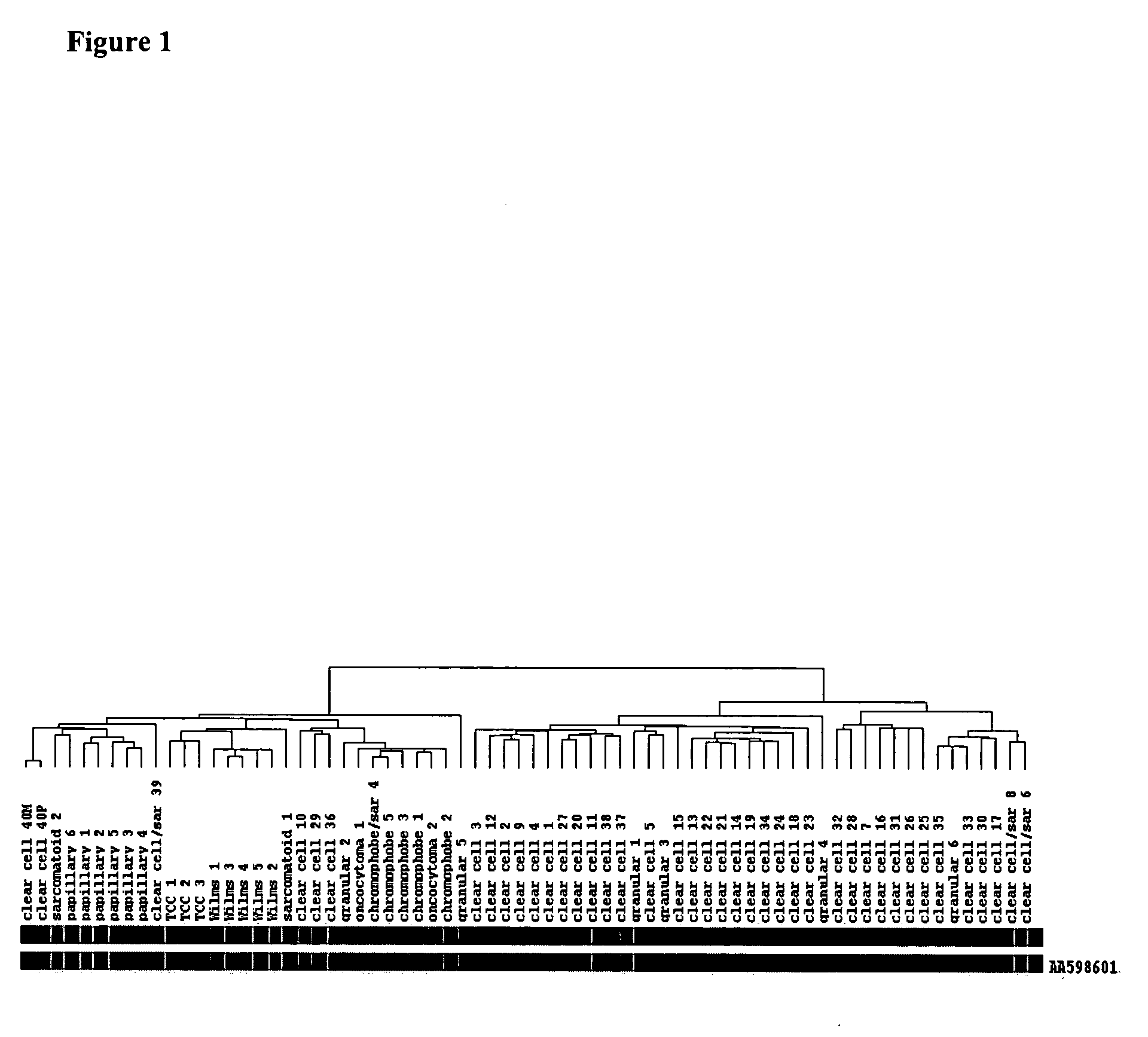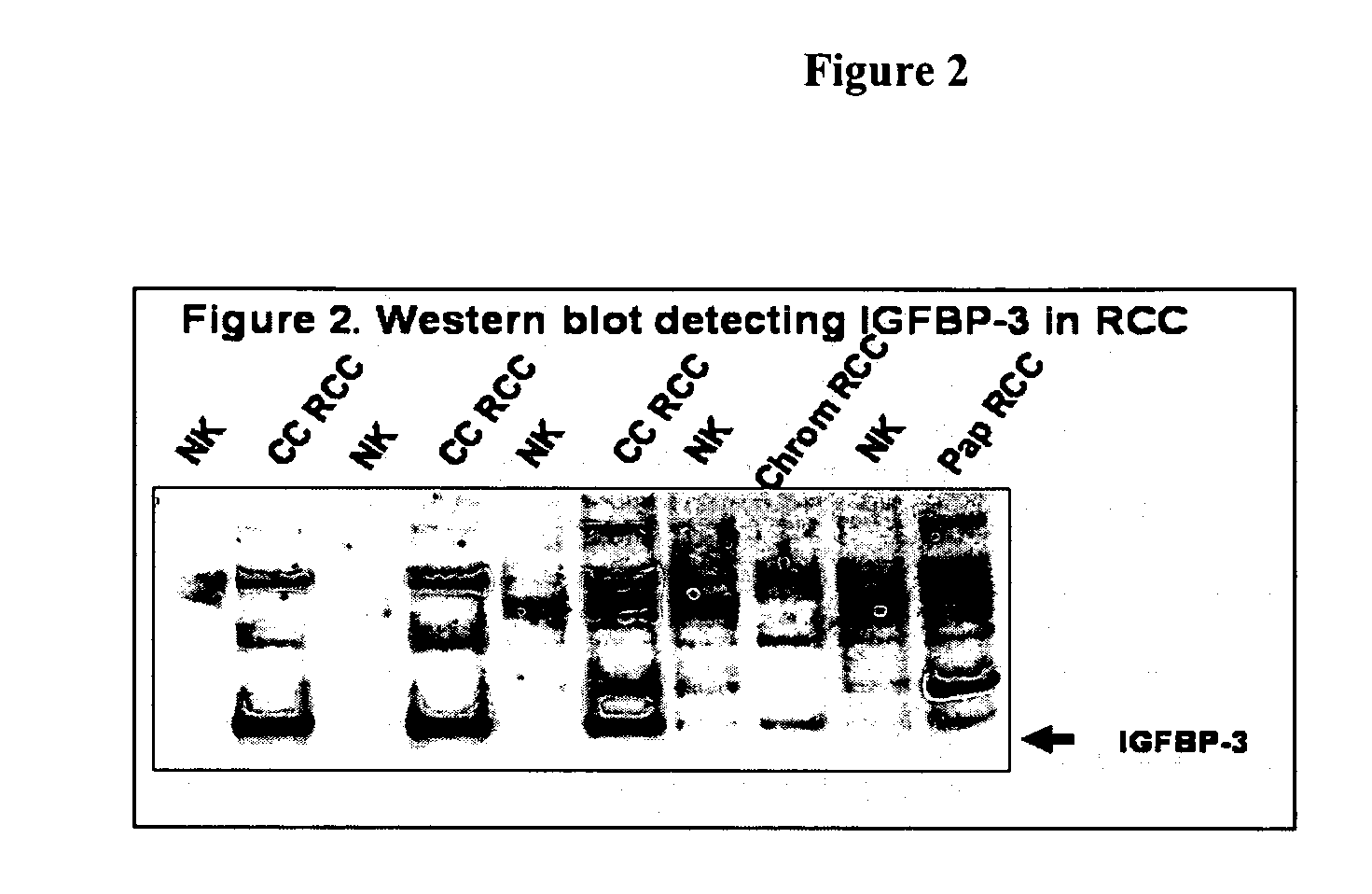Detection and treatment of renal cancer
a technology for renal cancer and detection and treatment, applied in the field of cancer therapies and diagnostics, can solve the problems of cancer, or malignancy, crowding out healthy cells, and invasive biopsies,
- Summary
- Abstract
- Description
- Claims
- Application Information
AI Technical Summary
Benefits of technology
Problems solved by technology
Method used
Image
Examples
example 1
Analysis of IGFBP-3 in Renal Cell Carcinoma and Urothelial Carcinoma
1. IGFBP-3 mRNA in Kidney Tumor
[0222] By expression (cDNA) microarray analysis of 70 renal tumors, increased expression of IGFBP-3 mRNA was found in the majority (28 / 43, 63%) of clear cell renal cell carcinoma (CCRCC). Particularly, high grade CCRCC defined by Fuhrman nuclear grades 3-4 showed overexpressed IGFBP-3 mRNA in 79% (11 / 14) compared to that in 55% (16 / 29) of low grade (Fuhrman grades 1-2) CCRCC. While 2 / 3 (67%) urothelial carcinomas and only 1 of all other 24 (4%) renal tumors demonstrated elevated IGFBP-3 mRNA (see FIG. 1). The results of mRNA analysis are listed in Table 2.
TABLE 2IGFBP-3 mRNA levels in 70 renal tumorsHigh GradeLow GrademRNA levelCCRCCCCRCCOther tumorsIncrease11163No change1106Decrease2318Total142927
2. Western Blot of IGFBP-3 in Renal Tumors
[0223] A monoclonal antibody specific for IGFBP-3 and tissue extracts from 10 kidney specimens was used to analyze the IGFBP-3 in renal tumor...
example 2
Analysis of Ceruloplasmin in Renal Cell Carcinoma
[0239] Ceruloplasmin is a copper binding protein, which can be measured in a routine clinical pathology laboratory for determine the status of copper overloading diseases such as Wilson's disease.
1. Western Blot for Ceruloplasmin
[0240] In this study, the ceruloplasmin protein expression in 5 kidney tumors (T1-T5) was compared to matching normal kidney tissues (K1-K5). In 3 CCRCC (T1-T3), there were strong ceruloplasmin bands, while papillary and chromophobe RCCs also showed weaker ceruloplasmin bands (FIG. 3). None of the normal kidney specimens showed detectable ceruloplasmin. The loading of the extracts of specimens was based on the total protein amount. The results shown here indicate ceruloplasmin is not only present in CCRCC but also in other renal carcinoma such as papillary RCC and chromophobe RCC.
2. Ceruloplasmin Immunohistochemistry in Kidney Tumors
[0241] Ceruloplasmin expression in 80 renal tumors was assayed using a...
example 3
ANGPTL-4 Expression in Renal Carcinoma
[0242] ANGPTL-4 is also known as Peroxisome Proliferator-Activated Receptor Gamma Angiopoietin Related Protein (ANGPTL4, PGAR). The relationship between this protein and renal cell carcinoma is not well studied.
1. ANGPTL-4 mRNA Levels
[0243] ANGPTL-4 mRNA levels were elevated in more than 96% of CCRCC, ranging from 14.1 folds to 8.1 folds of increase compared to normal kidney tissues. In an analysis of ANGPTL-4 mRNA levels in 150 renal tumors generated from cDNA microarrays, a marked elevation of ANGPTL-4 in CCRCC was observed. The average ANGPTL-4 mRNA levels of CCRCC was 12.4 folds, while other renal tumors showing no changes or an mild increase of ANGPTL-4 mRNA levels less than 2.5 folds compared to normal kidney tissues (FIG. 4).
2. Production of ANGTP-4 Antibodies
[0244] Three types specific antibodies were generated, two against synthetic peptides and one against recombinant fusion protein produced by E. coli expressing the ANGPTL-4 c...
PUM
 Login to View More
Login to View More Abstract
Description
Claims
Application Information
 Login to View More
Login to View More - R&D
- Intellectual Property
- Life Sciences
- Materials
- Tech Scout
- Unparalleled Data Quality
- Higher Quality Content
- 60% Fewer Hallucinations
Browse by: Latest US Patents, China's latest patents, Technical Efficacy Thesaurus, Application Domain, Technology Topic, Popular Technical Reports.
© 2025 PatSnap. All rights reserved.Legal|Privacy policy|Modern Slavery Act Transparency Statement|Sitemap|About US| Contact US: help@patsnap.com



